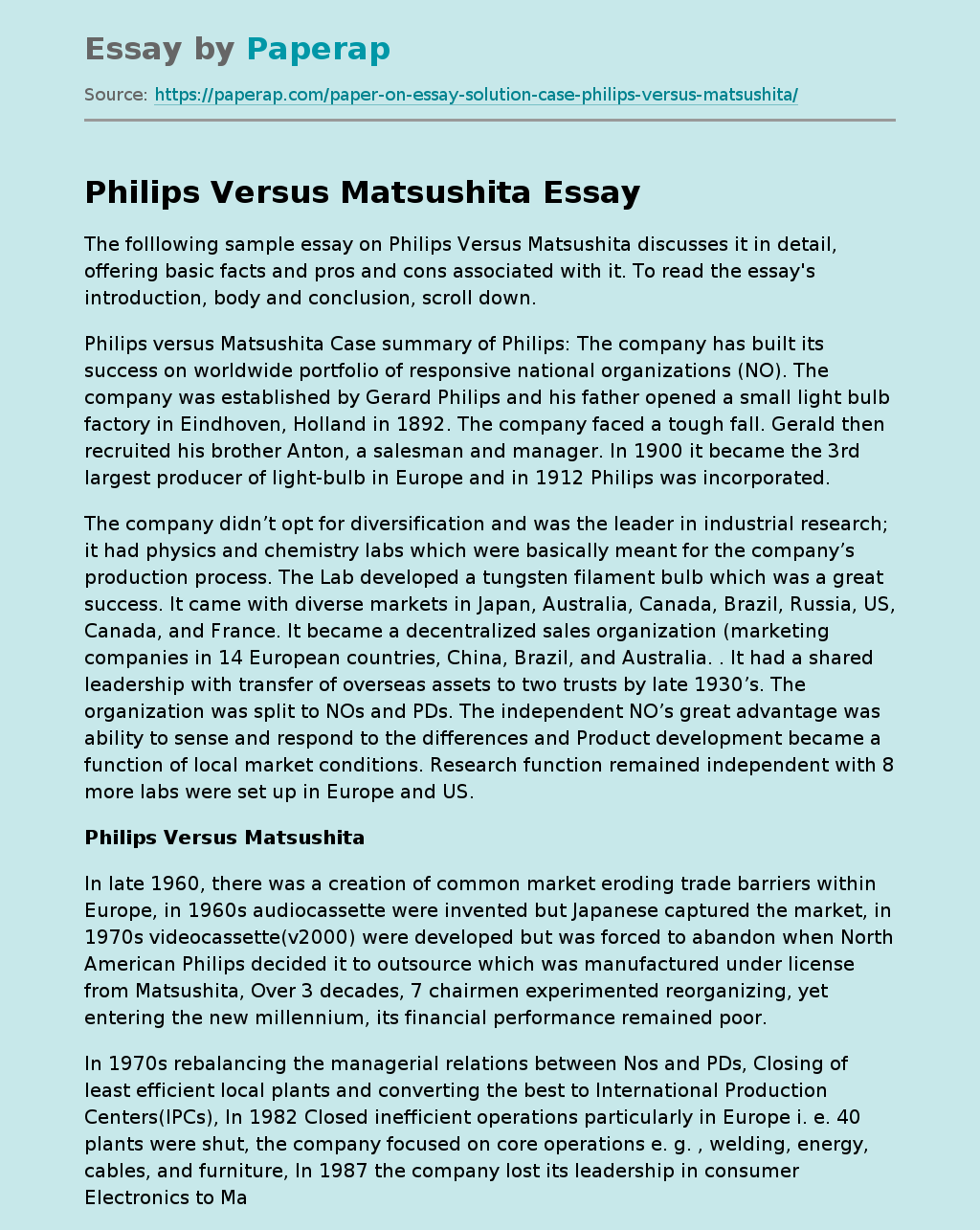Sample Essay on Philips Versus Matsushita
Philips versus Matsushita Case summary of Philips: The company has built its success on worldwide portfolio of responsive national organizations (NO). The company was established by Gerard Philips and his father opened a small light bulb factory in Eindhoven, Holland in 1892. The company faced a tough fall. Gerald then recruited his brother Anton, a salesman and manager. In 1900 it became the 3rd largest producer of light-bulb in Europe and in 1912 Philips was incorporated.
The company didn’t opt for diversification and was the leader in industrial research; it had physics and chemistry labs which were basically meant for the company’s production process.
The Lab developed a tungsten filament bulb which was a great success. It came with diverse markets in Japan, Australia, Canada, Brazil, Russia, US, Canada, and France. It became a decentralized sales organization (marketing companies in 14 European countries, China, Brazil, and Australia. . It had a shared leadership with transfer of overseas assets to two trusts by late 1930’s.
The organization was split to NOs and PDs. The independent NO’s great advantage was ability to sense and respond to the differences and Product development became a function of local market conditions. Research function remained independent with 8 more labs were set up in Europe and US.
In late 1960, there was a creation of common market eroding trade barriers within Europe, in 1960s audiocassette were invented but Japanese captured the market, in 1970s videocassette(v2000) were developed but was forced to abandon when North American Philips decided it to outsource which was manufactured under license from Matsushita, Over 3 decades, 7 chairmen experimented reorganizing, yet entering the new millennium, its financial performance remained poor.
In 1970s rebalancing the managerial relations between Nos and PDs, Closing of least efficient local plants and converting the best to International Production Centers(IPCs), In 1982 Closed inefficient operations particularly in Europe i. e. 40 plants were shut, the company focused on core operations e. g. , welding, energy, cables, and furniture, In 1987 the company lost its leadership in consumer Electronics to Matsushita with Net profit margins of 1% – 2%. The core business was of components, consumer lectronics and Telecommunication and Data systems, and lightning. The non-core businesses were spun off into joint ventures. The company reduced 3000 strong headquarters staff, and to gain firmer control over Nos, the publicly owned NAPC was repurchased for $700 million, In 1990, the company had undergone highest layoff with 15 months’ pay, the company recruited Frank Carrubba, Hewlett-Packard’s director of research and was encouraged to develop 15 core-technologies, including CD-I, DCC, HDTV, and Multimedia softwares.
By early 1998, betting on “digital revolution” the company planned to focus on established technologies such as cellular phones, digital TV, digital videodisc, and web TV. MATSUSHITA: The Global competitiveness based on its centralized, highly efficient operations in Japan. It was formed in 1918 by Konosuke Matsushita with Y100 producing double-ended sockets. The company introduced TV sets in 1952, transistor radios in 1958, color TVs, dishwashers, and Electric ovens in 1960. Innovating division had earned substantial profits; new division for innovation was introduced. One- product- one-division” was followed. Each division paid 60%earnings to headquarters and Product development and engineering occurred in product divisions. In 1951, the company found no American company willing to collaborate; the best which was done was technology Exchange and Licensing agreement with Philips. The company expanded through color TV. In 1953, it opened 1st overseas branch office, and shifted production to low-wage countries, In 1980, it built Global leadership through VCRs.
The company won the 1st place in Consumer Electronics industry with the birth of VCR, between 1977 to 1985, the capacity increased to 6. 8 million units. In the mid 1980s, Matsushita had over 700 expatriate Japanese managers and technicians on foreign assignment. General managers of foreign subsidiaries had to visit Osaka headquarters at least 2-3 times each year or some even months. In 1990, the company launched “operation localization” to boost the offshore production from less than 10% to 25% or half of international sales.
In 1986, the company felt that no sufficient attention was given to international development as they got only 3% royalty for foreign production against 10%return on sales for exports from Japan. All foreign subsidiaries were bought under the control of METC. At the end of 1989, company generated huge reserves. By the end of 2000, 160 factories outside Japan employed 1,40,000 people and investments were made in R&D partnerships and technical exchanges. In April 2000, profits were 2. 2%on sales, and in November 2000 there was a rise in company’s earnings.
Philips needs to see this latest change as a genuine one, and needs to avoid considering it as just another new strategic direction. If it does this, and everyone is involved and committed, then we feel that they can return to the success they enjoyed last century. The prognosis is similar for Matsushita, as if its management engage in consultation with its workforce when undergoing its large-scale restructuring programme and carefully analyse the dynamic relationship between strategy and structure when doing so, its restructuring programme has every chance of succeeding. Thus, Matsushita may once again be able to return to the levels of success it .
Sample Essay on Philips Versus Matsushita. (2019, Dec 07). Retrieved from https://paperap.com/paper-on-essay-solution-case-philips-versus-matsushita/

